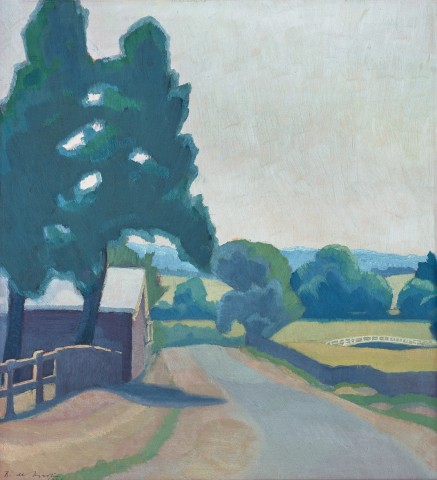THE PINES also known as SUTTON FOREST, 1921
ROY DE MAISTRE
oil on cardboard
29.0 x 27.0 cm
signed and dated lower left: R. de Mestre / 1921
Mrs Rodney Dangar, Sydney (bears inscription verso)
Thence by descent
Private collection, Sydney
Christie’s, Sydney, 3 – 4 October 1972, lot 266 (as 'The Pines')
Joseph Brown Gallery, Melbourne
Mr Alan Greenway, Australia and USA, acquired from the above
Thence by descent
Private collection, California, USA
Loan Exhibition of Roy de Maistre Paintings, Industrial Art Society’s Rooms, Sydney, 21 April – 5 May 1937, cat. 5 (as ‘Sutton Forest’)
In August 1919, Roy de Maistre (then known as Roi de Mestre) and his colleague Roland Wakelin held Australia’s first modernist exhibition at Gayfield Shaw’s Art Salon in Sydney. It was a show full of vibrant colour matched to a musical scale of the artists’ devising. Of the fourteen works shown, eleven were Cubist-informed scenes of the harbour’s foreshores and boatsheds, but the remainder were non-objective abstractions, a genre never seen before in this country. Titled Colour in Art, the event still generates fascination and comment over a century later but it needs to be emphasised that this was only a starting point for both artists, and their subsequent careers took many divergent paths as the years progressed. Indeed, within a year Wakelin and de Maistre began studying the controversial ‘tonalist’ theories presented by the Scottish-born artist Max Meldrum, an approach in apparent opposition to the ideas proposed through Colour in Art.
In December 1919, Meldrum’s student Colin Colahan published a book entitled Max Meldrum: his art and views, centred around a key lecture from 1917 which argued that ‘tone and proportion gives us what is generally called ‘a perfect work of art’, without any relation to the actual amount of time which the Artist has bestowed upon his picture.’1 Meldrum believed that the careful perception and analysis of tone and tonal relationships would produce an exact appearance of the thing seen. The gallerist and framer John Young purchased several copies of the book which he gave to his artist-friends, including de Maistre, who subsequently attended a lecture when Meldrum visited Sydney for six weeks in 1921. Such was his powers of persuasion that other Sydney artists were also intrigued by his theories, including Wakelin, Grace Cossington Smith, Elioth Gruner, and Lloyd Rees. The Pines, 1921, is one of a small number of Meldrum-esque works painted by de Maistre and it depicts a scene near his family home in Sutton Forest in the southern highlands of New South Wales. It is a testament to his strong self-belief that de Maistre’s does not completely abandon colour, as evidenced by the deep green of the two pines counterbalanced by patches of soft violet within the shadows and the surface of the road, strategies which give greater intensity to the more muted tonal phrasing championed by Meldrum.
Related paintings that fall within this fascinating sequence depict Government House in Sydney, other views of Sutton Forest and floral bunches of which Still life (aka White Roses), 1922 (Art Gallery of New South Wales) became his winning entry into the Society of Artists’ Travelling Scholarship, allowing for his first overseas journey in 1923. With its assured touch and pleasing subject, The pines was purchased directly from the artist by his key patrons and friends Rodney and Elsie Dangar, a wealthy couple who owned a number of residences including the mansion-property Rotherwood in Sutton Forest, and whose uncle owned Dangar Island in Sydney’s Pittwater region. Their notable collection featured works by Gruner, Wakelin, Charles Conder and Rupert Bunny; and in 1937, Elsie organised a loan exhibition of de Maistre’s paintings at the Industrial Art Society’s Rooms in Sydney where The pines (as ‘Sutton Forest’) was hung alongside the other nine works they owned. Last sold at auction in 1972, The pines has not been seen publicly during the interceding five decades and represents an exciting re-appearance for the artist’s catalogue.
1. Meldrum, M., ‘The invariable truths of depictive art’, 1917, in Colahan, C. (ed.), Max Meldrum: his art and views, McCubbin, Melbourne, 1919, p. 43
ANDREW GAYNOR
